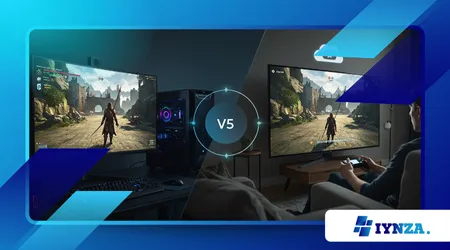Cloud Gaming vs. Traditional Gaming: Which One is Better?

The way we play games has changed. What once required a physical disc, a console, or a powerful PC, can now be streamed through the internet in real time. The emergence of cloud gaming is shifting the industry and raising one big question: cloud gaming vs. traditional gaming — which one is better?
Anúncios
It’s not just about technology. It’s about convenience, performance, accessibility, and how players connect to the experience. Some embrace the cloud for its simplicity.
Others defend traditional setups for their power and reliability. But before choosing a side, it’s important to understand what each one offers and what it demands in return.
This article breaks it all down — no jargon, just the real differences that matter to everyday players.
The Basics of Cloud Gaming
Cloud gaming lets you play video games without needing to download, install, or own the hardware to run them.
Instead, the games are stored on remote servers. When you play, you stream the game in real time, similar to how you’d stream a movie on Netflix.
You use a device like a smartphone, tablet, or lightweight laptop. The heavy lifting — processing and rendering — happens on a server somewhere else.
With a strong internet connection, it’s smooth and seamless. No updates, no patches, no storage worries. It feels futuristic. And for many, it is.
Traditional Gaming: How It Works
Traditional gaming is what most people know. It involves running a game directly on your local device. Whether it’s a high-end gaming PC, a console like the PlayStation or Xbox, or even a handheld system, the hardware is in your hands.
You buy the game, install it, maybe insert a disc, and play. Everything happens on your machine. The performance you get depends on the power of your system.
This approach has been refined for decades. It’s stable, consistent, and doesn’t rely on external conditions like internet speed.
Read also: How to stay focused during long gaming sessions
Accessibility: Who Can Play?
When comparing cloud gaming vs. traditional gaming, accessibility stands out as one of the biggest contrasts.
Cloud gaming opens doors. You don’t need a $2000 PC or the latest console. If your internet is solid, even a basic Chromebook can run AAA titles. No downloads. No hardware upgrades. It’s all about flexibility.
Traditional gaming, however, demands more upfront investment. You need the right machine. Some games won’t run unless you meet minimum requirements. And when new games launch, upgrades often follow.
So, cloud gaming removes technical barriers. But it adds a new one — internet quality. Not everyone has access to fast, stable connections. Especially in rural areas.
Cost and Investment
Hardware is expensive. So are games. Traditional gaming often starts with a big purchase — a console, or a full-spec PC. Then comes accessories, monitors, subscriptions, and the games themselves.
Cloud gaming flips that. You don’t need powerful hardware. You subscribe to a service, like Xbox Cloud Gaming or GeForce NOW, and gain access to a wide library.
Let’s look at a simplified comparison:
| Expense | Traditional Gaming | Cloud Gaming |
|---|---|---|
| Console or PC | $400–$2000 | $0 (existing device) |
| Game Purchases | $30–$70 each | Included in subscription or pay-per-use |
| Subscription Services | Optional | Required (avg. $10–$20/month) |
| Upgrades & Repairs | Frequent over time | None |
Cloud gaming often wins in short-term cost. But if you play often, subscriptions add up. And traditional hardware may last for years, making the investment worthwhile in the long run.
Performance and Latency
This is where traditional gaming fights back.
Performance in cloud gaming depends heavily on your internet. A slow or unstable connection means lag, input delays, or buffering. And while services like Stadia or GeForce NOW use powerful servers, the experience isn’t always perfect.
Traditional gaming is local. That means no latency, no internet dependency. Frame rates are higher, graphics are sharper, and response times are instant. Competitive players feel this difference immediately. For them, milliseconds matter.
Cloud services are improving. But for now, traditional systems still deliver the best raw performance.
Game Library and Ownership
When you buy a physical or digital game on a console or PC, you own it. Even if the store shuts down, it’s yours. You can back it up, mod it, replay it whenever.
Cloud gaming is more like renting. You stream the game from a server you don’t control. If the service ends, or a game leaves the library, it’s gone. That changes the relationship between players and their games.
Ownership gives players a sense of permanence. It builds collections. Streaming focuses on access, not possession.
Which one feels better depends on the gamer.
Portability and Device Freedom
Cloud gaming shines here. You can play from nearly any device — a phone, a TV, a tablet, even a browser. Your progress syncs automatically. No need to carry equipment or save files. It’s gaming on the go.
Traditional setups are limited. A console stays home. A gaming PC isn’t portable. Laptops offer some flexibility, but they’re not always optimized for high-end gaming.
For players who travel, commute, or prefer flexibility, cloud gaming is hard to beat.
Reliability and Offline Access
What happens when the internet goes down?
Traditional gaming keeps going. Most single-player games run just fine offline. You’re in control. No servers. No dependencies.
Cloud gaming doesn’t work without internet. No signal, no game. Even minor outages disrupt gameplay. And during peak hours, server congestion can hurt performance.
So while cloud gaming offers mobility, it lacks reliability. Traditional systems still rule when offline access matters.
Future Potential
Cloud gaming is evolving fast. Tech giants like Microsoft, NVIDIA, and Amazon are investing heavily. Compression algorithms are improving. Server infrastructure is expanding. Latency is dropping.
The dream? Seamless, high-performance gaming from any screen. Instant access. No downloads. No barriers.
Traditional gaming won’t disappear. But it may evolve. Consoles might shrink. PCs may become hybrid hubs. And cloud systems may integrate into everyday devices.
In the long run, both models could merge. Gamers might not have to choose. They’ll switch based on mood, location, or title.
Cloud Gaming vs. Traditional Gaming: A Matter of Lifestyle
It’s not about which is objectively better. It’s about what fits your lifestyle.
If you value performance, control, and ownership — traditional gaming is your world. If you want convenience, affordability, and flexibility — cloud gaming might be your path.
The good news? You don’t have to pick just one. Many players mix both. Game on the cloud during lunch. Fire up the console at night. There’s room for all styles.
In the end, the future of gaming is choice. And that’s the best win of all.
Questions About Cloud Gaming and Traditional Gaming
Is cloud gaming suitable for competitive multiplayer games?
It can be, but latency may affect performance. Traditional setups still offer better real-time responsiveness.
Do I need fast internet for cloud gaming?
Yes. A stable connection with at least 25 Mbps is ideal for smooth gameplay. Lower speeds can cause lag and buffering.
Are cloud gaming subscriptions worth it?
For casual or flexible gamers, yes. You get access to a wide library without heavy investment. Frequent players may still prefer ownership.
Can I play cloud games on my smart TV?
Yes, many services support smart TVs through apps or web browsers. You just need a controller and good internet.
Is traditional gaming becoming obsolete?
Not at all. It’s evolving alongside cloud gaming. Both models will likely coexist, giving players more ways to play.
